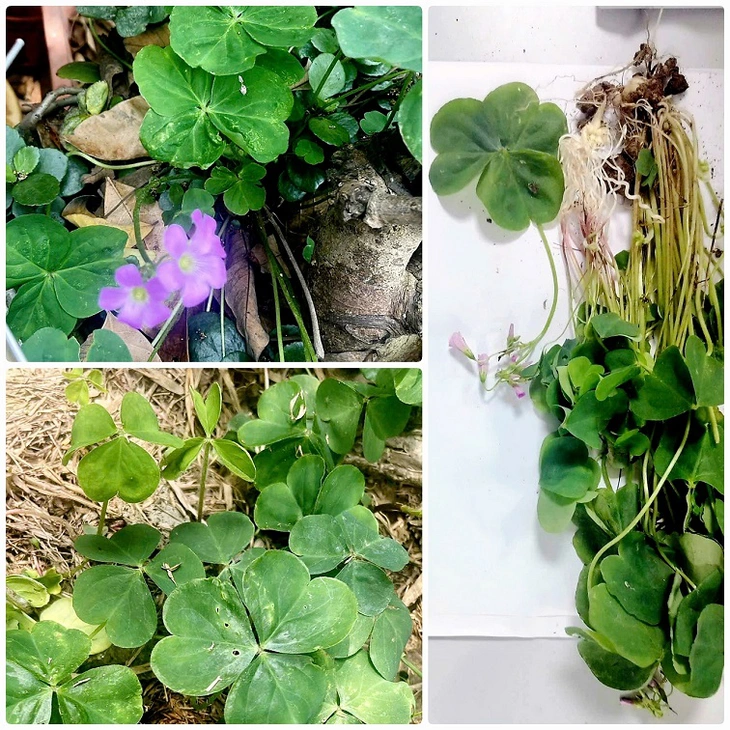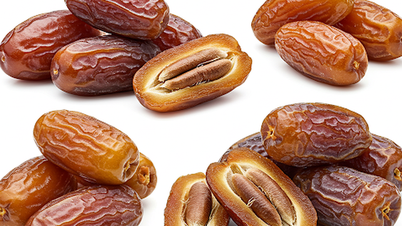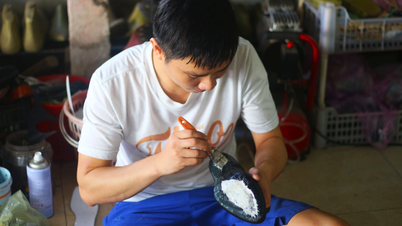The patient picked the tamarind tree and boiled it in water to drink, leading to kidney failure - Sample provided by the patient
Heard 'on the internet' that it can cure kidney stones and diabetes
According to the patient, she saw people sharing on the internet about the tamarind tree having cooling and detoxifying effects, and her aunt also often boiled it to drink to treat kidney stones and diabetes. Seeing that there were many plants growing in her garden, she pulled them out to use.
After pulling up a large basket of about half a kilogram, she boiled the roots, condensing 1.5 liters of water down to 600ml, about 3 drinking glasses.
She drank two cups herself and gave one cup to her 85-year-old mother. After a short while, she felt uncomfortable, nauseous and vomited fluid.
The next morning she woke up and went about her daily activities as usual, but she felt tired, had a headache, and was dizzy. After two days, she still felt tired and had no appetite, so she went to the hospital for a check-up.
At Bach Mai Hospital, doctors at the Poison Control Center said the patient was admitted conscious, without fever, weakness, nausea, or abdominal pain, and mainly complained of a dull headache. Urine and blood tests showed that the creatine level was many times higher than normal, a sign of kidney damage and acute kidney failure.
The patient's sample was sent to a specialist and identified as Oxalis corymbosa DC.
The test results of the item (the sample of tamarind the patient drank) at the National Institute for Food Safety and Hygiene Control showed that it contained oxalic acid. This is the cause of kidney failure when the patient drinks too much.
Dr. Nguyen Trung Nguyen - Director of the Poison Control Center, Bach Mai Hospital - said that oxalic acid is considered an agent that causes kidney damage and kidney failure if ingested in large amounts. More severe conditions will cause acute poisoning and can lead to death.
Rare poisoning from purple tamarind
According to Dr. Nguyen, the center has received patients with oxalic acid poisoning and kidney failure due to direct ingestion of this chemical. However, this is the first recorded case of a patient being diagnosed with kidney failure after ingesting a plant containing oxalic acid.
When searching the world's medical literature, we have not found any reports or studies recording people being poisoned by this plant.
Accordingly, oxalic acid (oxalate salt) is an organic acid with quite strong acidity, about 10,000 times stronger than acetic acid. Under normal conditions, oxalic acid exists in crystalline form, easily soluble in water to form a colorless solution with a sour taste.
At high doses, oxalic acid can easily irritate the intestinal mucosa and at pure doses of 4-5g can potentially cause acute poisoning, even leading to death.
The toxic dose (LD50) of pure oxalic acid is estimated to be 378 mg/kg body weight (about 22.68 g/60 kg person).
The combination of oxalic acid with calcium creates calcium oxalate, which can cause precipitation and deposition to form stones in the urinary organs, liver, gallbladder, pancreas... or accumulate in the joints.
Oxalic acid can be found in vegetables, tubers, and fruits that we consume every day such as star fruit, lemon, grapes, tamarind, beetroot, cocoa, spinach, tea leaves, bok choy, celery... The easy way to recognize when eating foods containing oxalic acid is that they have a sour, astringent taste.
However, with normal daily consumption of these foods, the amount of oxalic acid taken in does not affect health. With tamarind, it is famous for its ingredients containing oxalic acid and perhaps more than other plants.
Even common, edible plants can be poisonous if consumed in excess.
Dr. Nguyen emphasized that this is a typical example of a type of herb, even if it is recorded as being edible, but if eaten in excess, it can also lead to poisoning.
Besides, the issue of using herbs to treat diseases, although considered herbal, sounds benign, and some are even used as medicine, but as medicine, it is necessary to follow the principles of medical examination and treatment, drug management and drug use.
People should absolutely not believe or follow information on the internet or word of mouth to avoid unfortunate consequences.
Read moreBack to Topic Page
WILLOW
Source: https://tuoitre.vn/bi-ngo-doc-chua-tung-thay-trong-y-van-the-gioi-sau-khi-uong-nuoc-cay-me-dat-de-thanh-nhet-giai-doc-20250422151147864.htm

























![[Photo] General Secretary To Lam meets with Chairman of the Federation Council, Parliament of the Russian Federation](https://vphoto.vietnam.vn/thumb/1200x675/vietnam/resource/IMAGE/2025/5/10/2c37f1980bdc48c4a04ca24b5f544b33)
![[Photo] Ho Chi Minh City: Many people release flower lanterns to celebrate Buddha's Birthday](https://vphoto.vietnam.vn/thumb/1200x675/vietnam/resource/IMAGE/2025/5/10/5d57dc648c0f46ffa3b22a3e6e3eac3e)
































































Comment (0)